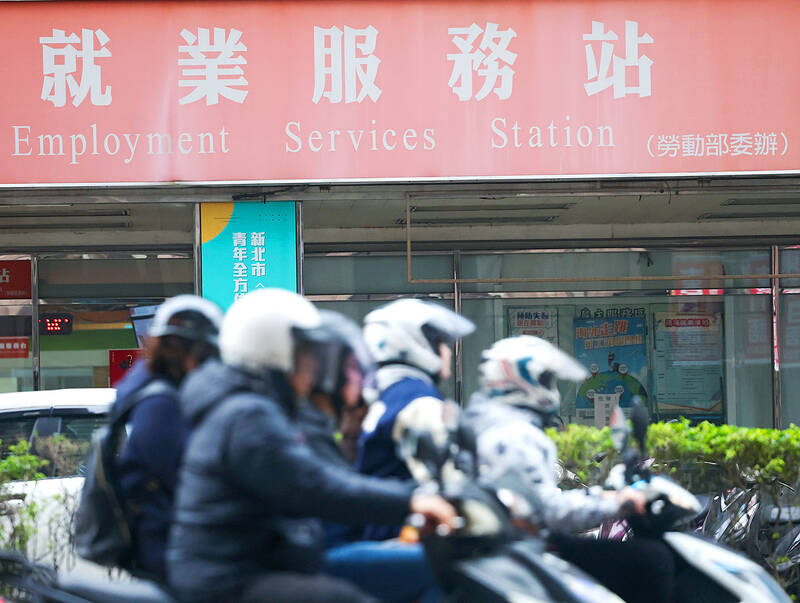The unemployment rate fell 0.1 percentage points year-on-year to 3.38 percent last year, the lowest in 24 years, as Taiwan continued to reap a windfall from investment by global technology titans in building artificial intelligence (AI) capacity, the Directorate-General of Budget, Accounting and Statistics (DGBAS) said yesterday.
That came as the unemployment rate last month dropped 0.04 percentage points month-on-month to 3.32 percent, as more first-time jobseekers landed positions and fewer people lost work to seasonal or temporary hiring, the statistics agency said.
The jobless rate would ease further this month as retailers, restaurants and entertainment facilities are raising headcounts to meet seasonal business needs ahead of the Lunar New Year holiday, Census Department Deputy Director Tan Wen-ling (譚文玲) said.

Photo: CNA
The downtrend would likely come to an end next month, when discontented workers would choose to move on after the holiday, Tan said.
The unemployment rate after seasonal adjustments lost 0.02 percentage points to 3.39 percent, affirming a stable job market, the DGBAS said.
The jobless population declined by 1.07 percent, or 4,000 people, to 399,000 last month, after the number of first-time jobseekers fell by 3,000 and the number of people who lost work to temporary or seasonal hiring decreased by 2,000, it said.
The unemployment period averaged 20.3 weeks, 0.8 weeks shorter than one month earlier, it added.
People with university degrees had the highest unemployment rate at 4.52 percent, followed by 3.21 percent for high-school graduates, 2.68 percent for those with junior-college diplomas and 2.66 percent for those with graduate degrees, the DGBAS said.
People with junior-high or lower education had the lowest unemployment rate at 2.13 percent, it said.
People aged 20 to 24 had the highest unemployment rate of 11.62 percent, as they tend to need more time adjusting to the real world, Tan said.
That was followed by the 15-to- 19 age bracket at 8.58 percent, those aged 25 to 29 at 5.87 percent and the 30-to-34 category at 3.36 percent, while people aged 45 to 64 had the lowest unemployment rate at 2.16 percent, the data showed.
Among major cities, unemployment rates last year were higher in Taipei and Keelung at 3.5 percent, and in a range of 3.3 percent to 3.4 percent in other parts of the nation, Tan said.

Nvidia Corp’s demand for advanced packaging from Taiwan Semiconductor Manufacturing Co (TSMC, 台積電) remains strong though the kind of technology it needs is changing, Nvidia CEO Jensen Huang (黃仁勳) said yesterday, after he was asked whether the company was cutting orders. Nvidia’s most advanced artificial intelligence (AI) chip, Blackwell, consists of multiple chips glued together using a complex chip-on-wafer-on-substrate (CoWoS) advanced packaging technology offered by TSMC, Nvidia’s main contract chipmaker. “As we move into Blackwell, we will use largely CoWoS-L. Of course, we’re still manufacturing Hopper, and Hopper will use CowoS-S. We will also transition the CoWoS-S capacity to CoWos-L,” Huang said

Nvidia Corp CEO Jensen Huang (黃仁勳) is expected to miss the inauguration of US president-elect Donald Trump on Monday, bucking a trend among high-profile US technology leaders. Huang is visiting East Asia this week, as he typically does around the time of the Lunar New Year, a person familiar with the situation said. He has never previously attended a US presidential inauguration, said the person, who asked not to be identified, because the plans have not been announced. That makes Nvidia an exception among the most valuable technology companies, most of which are sending cofounders or CEOs to the event. That includes

TARIFF TRADE-OFF: Machinery exports to China dropped after Beijing ended its tariff reductions in June, while potential new tariffs fueled ‘front-loaded’ orders to the US The nation’s machinery exports to the US amounted to US$7.19 billion last year, surpassing the US$6.86 billion to China to become the largest export destination for the local machinery industry, the Taiwan Association of Machinery Industry (TAMI, 台灣機械公會) said in a report on Jan. 10. It came as some manufacturers brought forward or “front-loaded” US-bound shipments as required by customers ahead of potential tariffs imposed by the new US administration, the association said. During his campaign, US president-elect Donald Trump threatened tariffs of as high as 60 percent on Chinese goods and 10 percent to 20 percent on imports from other countries.

INDUSTRY LEADER: TSMC aims to continue outperforming the industry’s growth and makes 2025 another strong growth year, chairman and CEO C.C. Wei says Taiwan Semiconductor Manufacturing Co (TSMC, 台積電), a major chip supplier to Nvidia Corp and Apple Inc, yesterday said it aims to grow revenue by about 25 percent this year, driven by robust demand for artificial intelligence (AI) chips. That means TSMC would continue to outpace the foundry industry’s 10 percent annual growth this year based on the chipmaker’s estimate. The chipmaker expects revenue from AI-related chips to double this year, extending a three-fold increase last year. The growth would quicken over the next five years at a compound annual growth rate of 45 percent, fueled by strong demand for the high-performance computing